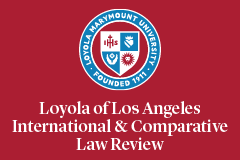Abstract
The COVID-19 pandemic has exposed some of the problems in the current pattern of global trade, particularly with respect to supply chain disruptions. To understand the current status of global trade, it is helpful to understand the confluence of four seemingly disparate developments: (1) Ricardo’s theory of comparative advantage in the early 1800s; (2) the rebuilding in the late 40s and 50s of our former adversaries—Japan and Germany—into export based economies; (3) the modification of capitalism in the 1980s to focus upon maximizing shareholder value; and (4) the rise of China as an economic and military powerhouse, facilitated initially by a low-wage manufacturing base. Ricardo’s concept of comparative advantage discusses: (1) how each country would be in a more advantageous position if it manufactured products that it is most efficient at producing, and (2) that allowing each country to specialize in the products it efficiently manufactures would be mutually beneficial to all countries involved when it comes to trade. However, disciples of Ricardo paid little attention to the two conditions that he articulated in order for his theory to work, both of which are no longer true today. Namely, that capital is loyal to the country of origin, and that currencies move to balance out trade deficits. With respect to maximizing shareholder value, this focus, coupled with cheap labor in China and other nations, led to American companies to outsource our manufacturing sector. The interests of other stakeholders, such as employees, customers, suppliers, and communities, were minimized. During the Bush 43 administration, the U.S. economy lost about 5 million manufacturing jobs, or about one third of the previous total. However, the major impetus for this blow to American workers came from President Clinton and his “free trade” philosophy, which led to the “most favored nation” status for China and, ultimately, the admission of China to the World Trade Organization. Unfortunately, China has never observed WTO principles regarding state-sponsored enterprises or policies against direct or indirect piracy of other countries’ technology. Today, the United States has lost its dominance in manufacturing, private sector labor unions have been greatly diminished, the economic situation of the middle class has stagnated for 40 years, and America’s free-market economic and political philosophy has led to governmental impasse and rising inequality. China is now expected to supersede the United States as the world’s number one economic power. This article asserts that, in order to provide high quality jobs for American workers, to protect American businesses against supply chain disruptions, and to ensure national security, the United States needs to adopt an industrial policy. Creating an industrial policy is something that many other advanced economies have already accomplished, as opposed to relying on the blind hand of the market to determine public policy. The mantra of free trade in the United States has hinged on giving away low-tech jobs and diverting our resources and workers into high-tech jobs. Conversely, China does have an industrial policy, and it is determined to be a leader, not just in low-tech manufacturing, but also in high-tech industrial and military activities. Unless we focus our attention on maintaining a manufacturing base, we are going to be second to China in many high-tech industries, and from a military standpoint, will lose much of our leverage to ensure peace in the world.
Recommended Citation
Charles W. Murdock,
Global Trade, WTO, Labor Arbitrage, American Workers and National Security—The Need for a U.S. Industrial Policy,
46 Loy. L.A. Int'l & Comp. L. Rev. 121
(2023).
Available at: https://digitalcommons.lmu.edu/ilr/vol46/iss2/2


